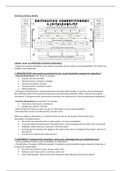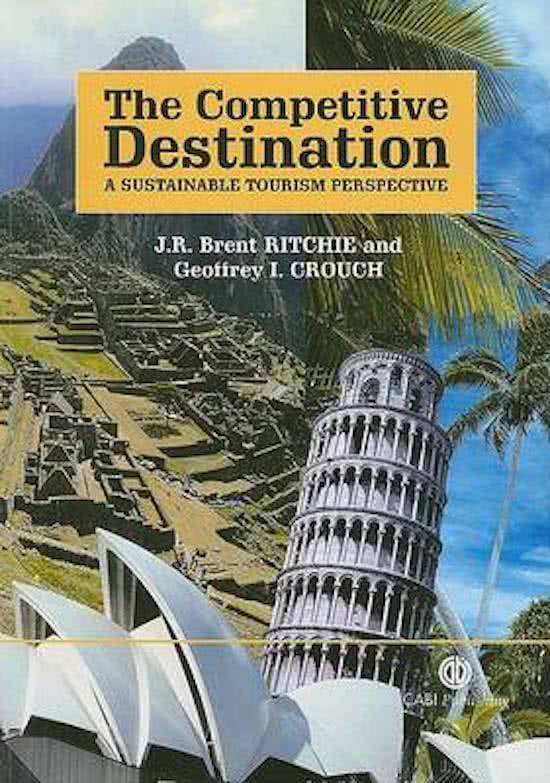RITCHIE & CROUCH MODEL
LOWEST LAYER SUPPORTING FACTORS & RESOURCES
= Support or provide a foundation upon which a successful tourism industry can be established. This factors are
needed to be competitive.
1. INFRASTRUCTURE: How would you evaluate the infra. at your destination compared to competitors?
= General infrastructure: First level. For example
• Airports, rail, bus terminals
• Electrical power, sanitation, drainage
• Telecommunications, internet
• Financial systems, education system
• National defence
= The general infrastructure is usually delivered by the government (public). They have a lot of involvement.
But sometimes, parts of the general infrastructure may have been privatised. What is the level of on-going
investment? Is the government continuously investing in the infrastructure? Are the repairing and updating it?
= Services infrastructure: Second level. For example
• Food stores, book stores, hairdressers
• Garages, gas stations, chemists
= All the things that helps you when you go to a destination and you need something
= Normally these services are delivered by a private sector.
When you analyse a destination, it is important that you discuss the quality of the infrastructure.
How good is the infrastructure?
• This cannot be measured with a simple number. It is more complicated
• It can vary within the destination. The general infra. can be amazing, but the service infra. can be bad.
• Reliability, safety, efficiency: How safe is the destination?
• Good design, for example: the signage at the airport, how clear is it designed how to get in and out of
the airport?
• How does the infrastructure help tourism?
2. ACCESSIBILITY: Compared with competitors, what access. advantages does your destination have?
= There are different aspects of the accessibility of a destination.
= The definition: The ease or difficulty involved in travelling to and entering the region concerned. How easy is
it to get into a destination?
• Are there any barriers to entry, do you need a visa?
• Political control: who comes in and who comes out?
• Airline landing rights: which airlines does the government allowed to land at the airport?
, • Tourism often wants more accessibility from government.
• How can your destination influence the accessibility? How can the increase the access.?
• For example: London’s main railway station, it shows a lot of possibilities how to get into the city. It is
very easy accessible.
3. FACILITATING RESOURCES: In what way do your destination’s facilitating res. give it a competitive
advantage?
= Human Knowledge resources: First category.
• Human resources: The number of people, the level of education of people.
• Expectations regarding skill levels needed: What level of education expectation does the destination
have, regarding to the level of skills the people should have?
• Tourism product is delivered by those working in tourism to serve the tourists. Who is the interface
between the tourists who visit the place and the locals who live there?
• Diversity of skills and knowledge
• Academic institutions: Are there specials training for tourism management?
• Specialists (tourism) courses/training
• Attitude to careers in tourism.
= For example: In London you have the blue badge tourist guide. This guides have to study 2 or 3 years before
they are officially allowed to guide in London. That says something about the importance of the level of
education and skills, the human knowledge, London prefers.
= Financial capital resources: Second category.
• Cost of human resources, for example wages, taxes?
• How much money is there? How much does it cost to employ someone in the tourism industry?
• Does tourism interest generate revenue? And Is that revenue fed back into improve the level of staff
for example, with training?
• How does destination encourage investment?
• How to foster a financially successful industry?
4. HOSPITALITY: How welcoming to tourism are the locals at your destination?
= Extremely important part in the tourism industry. It supports the tourism industry, without hospitality, the
tourists may not come back.
= Definition of hospitality: The behaviour or attitude of the locals/residents towards the tourists and the
tourism industry. The positive or negative attitude has a lot of influence on the tourism industry. Some aspects
of hospitality are:
• Hospitality of residents general supporting factor. For example, in Amsterdam: when there are
tourists cycling everywhere in front of you, you can become very annoyed. This can influence
your supporting factor against tourism. But if you work in the tourism industry, you will
encourage the tourists to come.
• How can destinations encourage permanent residents to be friendly to tourists? What are the steps a
destination takes to increase the positive attitude of residents against tourists? For example: In
Amsterdam, you have the “Welcome Amsterdam” event, where locals have to possibility to train and
learn how to deliver service.
• Extremely important aspects which have a huge impact on the experience for tourists are: High
service, warm welcome, well treated...
• Remember: friendliness on its own is NOT enough for a destination to become successful
• Tourists like to interact with people from the city. But not only the
communication and service between residents and tourists, for example taxi
drivers in a city or the waitress in a restaurant, there are also other aspects
that can influence the hospitality.
For example, this flyer shows that London likes to welcome tourists to their city. It
shows a positive feeling, with the slogan “Visit London, welcome to our world”.
5. ENTERPRISE: How dynamic is the enterprise community at your destination?
= Definition: Enterprise is given as the generation of human energy. All the companies/small business that try
, to provide more tourists. For example: all the souvenirs shops and the tourism attractions on a destination, but
also the large scaled hotels and airlines.
= We will focus on the small enterprises. Aspects are:
• The amount of competition: How much competition is there between suppliers?
• The cooperation: are the businesses working together?
• Specialization: Are there some specialized niche markets?
• Innovation: Is it easy for people to set up a new company?
• Facilitation: How is the tourism/business market facilitated by the local government?
• Investment: Is the government investing money? Are they encouraging or stimulating people to set up
a company or to grow?
• Risk-taking: Are people prepared to take risks? Is it worth to take risks?
• Gap-filling: When there is a gap in the market and a new service is needed, how quickly can this gap
be filled by a new entrepreneur with a good idea?
• Diversification: You need to make sure that you can come up or present different aspects of a
destination to different parts of the market, to different target groups.
• Seasonality: Different plans for different seasons.
• Disequilibrium: This means when there is an imbalance in one part of the market. How can a
destination solve this problem?
6. POLITICAL WILL: How much money do politicians at your destination actually invest in tourism?
= Last part of the lowest department of the R&C model. Aspect are:
• The attitude of government to tourism: Do they see tourism as positive, the contribute of the
economy? Or negative, is it complicated?
• Recognition of importance of tourism: For example, the government can stay that they do support
tourism, but on the other hand, they have cut the budget for tourism in half.
• Willingness of government to support tourism: How willing is the government to support?
• Backing-up support with money: How much money do they have to create new things, and how much
of this ideas have become reality?
• Help in setting constructive tourism policies: Is the government making it easy for people to come in
the country. Are they making it easy for hotels or other tourism companies, like tour operators, to
start a business? Or are there a lot of obstacles? When there is no help from the government, it is
really difficult to be competitive.
• Allocating scare resources: Scare means that they are missing or that there is a limited amount of it.
The government has to decide who gets it. So for example, related to the tourism: Most of the time
this resources goes to the bigger cities to improve tourism, instead of the small towns. For example:
the resources to access particular places, this often goes to the bigger tour operators. Most of the
time, this big cities and companies also pay the government to make the decisions favourable in their
place.
Example of political will: The bit for the Olympic game in 2007. On the picture you
can see the prime minister Tony Blair. He put himself on the line and his job on the
line. He is standing there right in the middle of the tourism bit, to get the Olympic
games to London. This shows how this politician support for 100% tourism for the
destination.
SECOND LAYER CORE RESOURCES AND ATTRACTORS.
= This resources are the primary elements of destination appeal. These factors are the key motivators for
visitation to a destination. They are the fundamental reasons that prospective visitors choose one destination
over another. The lowest part and this part are related to each other. A destination can have all the nice and
fantastic core resources, but at the end they need the supporting factors to become competitive.
7. PHYSIOGRAPHY AND CLIMATE: What unique physiography does your destination have and are they using
it effectively?
= A destination’s natural tourism attributes. In London, you’ve got the woods, the parks, hills, all the green. All
this aspects of physical landscapes, are part of the physiography and climate. Visitors are really attracted by the
nice pictures with the nice weather, but on the other hand, it rains a lot in London too.






